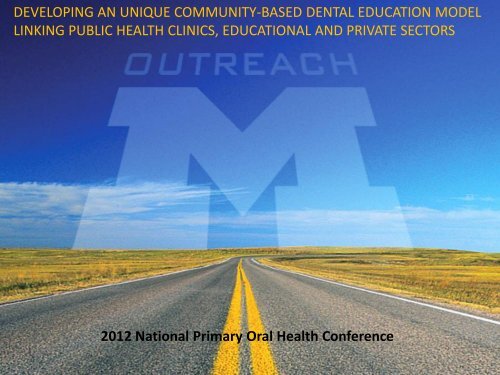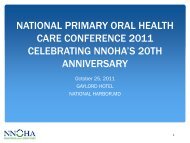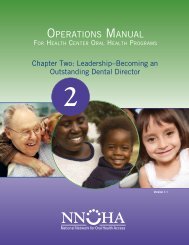Developing a Unique Community-Based Dental Education
Developing a Unique Community-Based Dental Education
Developing a Unique Community-Based Dental Education
You also want an ePaper? Increase the reach of your titles
YUMPU automatically turns print PDFs into web optimized ePapers that Google loves.
DEVELOPING AN UNIQUE COMMUNITY-BASED DENTAL EDUCATION MODEL<br />
LINKING PUBLIC HEALTH CLINICS, EDUCATIONAL AND PRIVATE SECTORS<br />
2012 National Primary Oral Health Conference
LEARNING OBJECTIVES –<br />
• Structure affiliation agreements with 4 common but different<br />
clinic models (funding mechanism) that develop, nurture, and<br />
sustain relationships with host sites that will increase access<br />
to care<br />
• Develop unique and valuable CBDE partnerships with<br />
community champions just by asking.
Intentions of an Association<br />
• What barriers do you expect<br />
• What settings are available in your state for developing a<br />
community-based dental education program<br />
• What resources are available to create and predictably sustain<br />
the program long term
Let’s us discuss the 5 P’s of<br />
collaboration<br />
• Public:<br />
• Policy:<br />
Who needs service and what types of services do<br />
they need?<br />
What will your State’s practice act allow you to do<br />
• Philosophies:<br />
What are the motives for involvement<br />
• Procedures:<br />
What is the Scope of Services that can be provided?<br />
• Philanthropy:<br />
Where is the money and manpower:<br />
Federal/State/Donated?
Know the Numbers !<br />
FY 2012 MDCH Budget<br />
• $12 Billion, Gross MDCH Budget<br />
• Federal Match: State, 34 cents to Federal, 66 cents<br />
• $145 Million gross, Medicaid <strong>Dental</strong> Services<br />
(1.2% of total MDCH Budget)<br />
• $19.6 million, FFS Adult <strong>Dental</strong> ($5.4 General<br />
Fund)<br />
• $68 million gross, HKD (61 of 83 counties)<br />
• $57.4 million gross, FFS (non-HKD counties)<br />
Medicaid Adult <strong>Dental</strong> and Healthy Kids<br />
<strong>Dental</strong> maintained at current levels
Public:<br />
Know the facts and opportunities<br />
Michigan Facts<br />
• Population, 9.9 Million<br />
• Uninsured: 1 Million<br />
• Medicaid: 1 Million children;<br />
666,000 adults<br />
• 1,004 hospitalizations in 2008 due to<br />
dental-related issues<br />
• 2.5 Days, average Length of Stay<br />
• $19,074 average cost per patient<br />
Source of funding: Local hospitals
MI <strong>Dental</strong> Care Workforce Facts<br />
• 6,715 dentists; 8,974 hygienists; 1,355 assistants<br />
• One county (Keweenaw) has no dentist<br />
• 2 dental schools<br />
• 12 dental hygiene programs<br />
• 9 dental assisting programs<br />
• 65 of Michigan’s 83 counties have a<br />
partial or full-county geographic or<br />
population group dental health care<br />
HPSA designation
Distribution of<br />
Dentists in<br />
Michigan per<br />
10,000<br />
Residents, by<br />
County, 2010
Michigan <strong>Dental</strong><br />
Component Societies
State of Michigan-Safety Net <strong>Dental</strong> Service Providers<br />
• Federal, State and <strong>Community</strong> developed clinics<br />
• 23 Federally Qualified Health Centers (FQHC’S) - 5 of these have<br />
special Migrant Population Designations.<br />
• 17 Local Health Departments out of 45 that offer Medicaid dental<br />
services through 27 clinics<br />
• 4 Native American dental clinics these clinics offer services<br />
• 55 Adolescent Health Centers of which 27 have an Oral Health<br />
Assessment component<br />
• Michigan Donated <strong>Dental</strong> Services:<br />
• 766 dentists, 177 laboratories, 383 people treated<br />
• Result: $824,744 of comprehensive care for elderly, disabled or<br />
medically compromised.<br />
• Unlimited opportunities<br />
Additional information can be found in Oral Health Program Directory<br />
www.michigan.gov/documents/directory_29654_7.pdf<br />
2006 Burden of Oral Disease in Michigan, Michigan Department of <strong>Community</strong> health
The State of Michigan provided $10 million in 1999 for a<br />
three-pronged attack.<br />
Money allocated to address the chronic access problem<br />
for dentally underserved populations<br />
• Provide funds to community clinics – both FQHCs and Local Government<br />
owned Public Health agencies to establish or expand dental clinics<br />
throughout the state,<br />
• Establish the Healthy Kids <strong>Dental</strong> Program in 37 counties, where<br />
community clinics do not exist, which is administered by Delta <strong>Dental</strong>, and<br />
uses Delta’s network of participating private practitioners, and<br />
• Provide start-up funds to establish the University of Michigan School of<br />
Dentistry <strong>Community</strong> Outreach Service Learning Program, which allows<br />
students to provide care in the community clinic setting.
Project Goal<br />
• Create a partnership with the Michigan Department of<br />
<strong>Community</strong> Health, safety net clinics and other community<br />
organizations and leaders to explore innovative programs to<br />
address the needs of the underserved.<br />
• Let’s review the results of this 10 million dollar initiative
Negotiating a Revenue Sharing<br />
Program is Predictable<br />
• “Development of a Sustainable <strong>Community</strong>-<strong>Based</strong> <strong>Dental</strong> <strong>Education</strong><br />
Program”, Wilhelm A. Piskorowski, D.D.S.;Mark Fitzgerald, D.D.S.,M.S.;<br />
Jerry Mastey, B.A.; and Rachel Krell, B.A. Journal of <strong>Dental</strong> <strong>Education</strong>,<br />
August,2011/Vol.75/No.8<br />
• “<strong>Dental</strong> School and <strong>Community</strong> Clinic Financial Arrangements”, Wilhelm<br />
Piskorowski,D.D.S.; Howard Bailit, D.M.D.,Ph.D.;Taegen L.McGowan,<br />
M.P.H.; Rachel Krell, B.A. Journal of <strong>Dental</strong> <strong>Education</strong>, October<br />
2011/Vol.75/No. 10 Supp.
Revenues in<br />
Selected <strong>Community</strong> Clinics<br />
(Mean Production/Student/Day)<br />
Clinic Type<br />
Daily<br />
Revenue<br />
Days<br />
Annual<br />
Revenue<br />
FQHCs – 2009<br />
(4)*<br />
<strong>Community</strong> -2010<br />
(5)*<br />
Private Practice -2009<br />
(1)*<br />
$806 364 $293,253<br />
$906 42 $38,350<br />
$870 78.5 $68,515<br />
*Number of clinics
** Medicaid adult benefits suspended<br />
Procedures:<br />
Patients and Procedures<br />
University of Michigan School of Dentistry<br />
<strong>Community</strong> Outreach Program<br />
10 wks<br />
3 wks<br />
8 wks<br />
5 wks<br />
4 wks<br />
3 wks**<br />
3 wks<br />
10 wks**<br />
* *<br />
*Combined efforts with AEGD and Grad –Op<br />
Does not include International/Specialized Projects Data
Source: US Census Bureau. Small Area Income & Poverty Estimates 2003
13,300 1,200<br />
Grand<br />
Traverse<br />
Philanthropy:<br />
12,100 7,400<br />
Outreach<br />
NW Michigan<br />
Health Services, Inc.<br />
Migrant Program<br />
Wolverine Project<br />
Grand Traverse<br />
Band of Ottawa<br />
and Chippewa<br />
Indians<br />
4,700 410<br />
4,390 1,200<br />
2,590<br />
(19%)<br />
Yet to<br />
be<br />
Served<br />
Target<br />
Population<br />
PA 161 -2010<br />
Resort District <strong>Dental</strong> Society<br />
Donated <strong>Dental</strong> Services<br />
Munson Healthcare<br />
System<br />
Other Charities
Traverse Health Clinic<br />
<strong>Dental</strong> Access Program
Policy:<br />
Traverse Health Clinic<br />
• <strong>Dental</strong> Access Program (DAP) = from 2006 to 2010, urgent<br />
dental needs were referred and oral health instruction was<br />
given<br />
• “Path to Prevention” = starting in 2010, Public Act 161 was<br />
implemented and the DAP was expanded
Traverse Health Clinic<br />
<strong>Dental</strong> Access Program<br />
Patients<br />
Volunter<br />
Services<br />
4 hours volunteered<br />
for every $100 worth<br />
of services received<br />
(C2 Program)
Growth of the <strong>Dental</strong> Access Program<br />
(DAP) by Volunteer DDS’s. and U of M<br />
school of Dentistry<br />
Fiscal Year(Oct- Sept) 2006-2007 $3,400<br />
2007-2008 $29,000<br />
2008-2009 $105,000<br />
2009-2010 $195,000<br />
* 2010-2011 $202,000<br />
PLUS UM $126,000<br />
($328,000)<br />
*Introduction of UM <strong>Dental</strong> Program
<strong>Community</strong> Service<br />
FY 2010<br />
Volunteer Hours<br />
to Complete<br />
FY 2010<br />
Volunteer Hours<br />
Completed<br />
FY 2011<br />
Volunteer Hours<br />
to Complete<br />
FY 2011<br />
Volunteer Hours<br />
Completed<br />
1920 1050.25 3930 1050<br />
55% 28%
2010-2011 Stats for DAP<br />
• 139 Patients signed up for the Program<br />
• 19 patients registered but did not participate<br />
• 120 received treatment<br />
• 54 (45%) are currently receiving restorative treatment*<br />
• 59 (50%) have completed restorative treatment and are in<br />
maintenance care<br />
• 7 (5%) required no treatment beyond screening and maintenance<br />
*19 have subsequently completed treatment in<br />
2012 where removable appliances valued at<br />
$50,000 were fabricated and delivered through a<br />
two day program called “Heavens Dent”
Philosophy:<br />
“Influence of <strong>Community</strong>-<strong>Based</strong><br />
<strong>Dental</strong> <strong>Education</strong> on <strong>Dental</strong><br />
Students’ Preparation and Intent to<br />
Treat Underserved Populations”<br />
• Wilhelm A. Piskorowski, D.D.S.; Stephen J. Stefanac, D.D.S.,<br />
M.S.; Mark Fitzgerald, D.D.S., M.S.; Thomas G. Green, Ph.D.;<br />
Rachel Krell, B.A. Journal of <strong>Dental</strong> <strong>Education</strong>, Volume 76,<br />
Number 5/May 2012
<strong>Community</strong>-based clinics as student first career<br />
choice compared to the number of weeks spent in<br />
outreach rotations from 1998-2010<br />
First Career Choice<br />
Weeks<br />
Spent in<br />
Outreach<br />
<strong>Community</strong><br />
Clinic<br />
AEGD/GPR<br />
Program<br />
Higher<br />
<strong>Education</strong><br />
Other<br />
Clinic<br />
Type<br />
Percent of<br />
Graduates<br />
Choosing<br />
<strong>Community</strong><br />
Clinics<br />
1998-2000 0 * * * * 1.7%<br />
2005 3 6 29 18 39 6.1%<br />
2006 3 6 24 23 42 6.1%<br />
2007 4 6 20 17 55 4.7%<br />
2008 5 7 30 23 44 5.6%<br />
2009 8 13 35 20 38 11.8%<br />
2010 8 18 28 11 46 16.5%
Pre and post rotation evaluations
Win-Win Outcomes<br />
• Win for the underserved communities (public) who<br />
experienced increased access to care<br />
• Win for the centers (policy) -increased and more consistent<br />
productivity of Federal, State and <strong>Community</strong> funds and<br />
programs<br />
• Win for the students( philosophy) who enhanced their<br />
clinical skills and broadened their experience base to<br />
include an ethic of caring<br />
• Win for the school( procedures) in the form of predictable<br />
and full coverage of all program costs<br />
• Win for sites (philanthropy) for they have noted a<br />
significant increase in recruitment of recent graduates as<br />
practitioners and interest in donated services thus helping<br />
to solve a chronic manpower problem
Staying Nimble<br />
• The community outreach endeavors are not static<br />
because we are always looking for the “best model”.<br />
• We always try to remember two important points.<br />
• First, since oral health care is a dynamic profession, nothing<br />
remains “as is” for very long.<br />
• We have to:<br />
• Continue to be nimble.<br />
• Do our best to adapt to the needs of our outreach<br />
partners who, in turn, are doing their best to respond to<br />
the needs of patients in their communities.<br />
• Remember that our flexibility and actions convey an<br />
important message to our students: they too will have to<br />
be adaptable as practitioners.
It is one of the most<br />
beautiful compensations of<br />
life that no person can<br />
sincerely try to help another<br />
without helping themselves.<br />
Ralf Waldo Emerson
13,300<br />
12,100<br />
10,710<br />
now<br />
have a<br />
dental<br />
home<br />
4,700<br />
4,390<br />
2,590<br />
(19%)<br />
Yet<br />
to be<br />
Served





